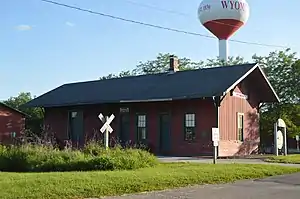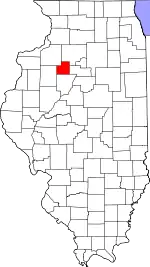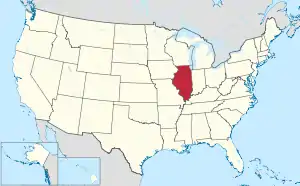Stark County, Illinois
Stark County is in Illinois. According to the 2020 census, it had a population of 5,400.[1] Its county seat is Toulon.[2]
Stark County | |
|---|---|
 | |
 Location within the U.S. state of Illinois | |
 Illinois's location within the U.S. | |
| Coordinates: 41°05′N 89°47′W | |
| Country | |
| State | |
| Founded | 1839 |
| Named for | John Stark |
| Seat | Toulon |
| Largest city | Wyoming |
| Area | |
| • Total | 288 sq mi (750 km2) |
| • Land | 288 sq mi (750 km2) |
| • Water | 0.3 sq mi (0.8 km2) 0.1% |
| Population (2020) | |
| • Total | 5,400 |
| • Density | 19/sq mi (7.2/km2) |
| Time zone | UTC−6 (Central) |
| • Summer (DST) | UTC−5 (CDT) |
| Congressional district | 16th |
| Website | www |
Stark County is part of the Peoria, IL Metropolitan Statistical Area.
History
Stark County was formed in 1839 out of Knox and Putnam counties. It was named for General Colonel John Stark (August 28, 1728 – May 8, 1822), who served in the American Continental Army during the American Revolutionary War. He became widely known as the "Hero of Bennington" for his exemplary service at the Battle of Bennington in 1777.
 Stark County at the time of its creation in 1839
Stark County at the time of its creation in 1839
In the latter part of April, 1829 a solitary, heavily laden wagon was wending its way from the hospitable home of Mr. French, at Prince's Grove, about a half mile north-west of the present town of Princeville, towards Spoon River, probably crossing that stream at a point since known as Boardman's Ford, or, as others think, near the seat of Cox's Mill, and moving on towards section fifteen in what has since been known as Essex Township.[3]
The weather was warm and balmy considering the season. The prairie burnt over by the Indians in the fall was already green with sprouting grass. Accompanying this vehicle were as it might seem a guard of good men, and true; "neighbors" they called themselves, although they must have lived many miles apart, some of them thirty or forty from the scene of their present friendly labors, having come from LaSalle Prairie, from Chillicothe and Peoria. They were neither hunters or warriors, they feared no enemy, and sought not the "spoils of war".[3]
It was a peaceable expedition and its leader was the occupant of the wagon, Isaac B. Essex, then in the strength of his manhood, and with him came his young wife and infant child to found a home in the wilderness. The "neighbors" were Daniel Prince, Stephen French, Simon Reed, Frank Thomas and two Baptist ministers, Elders Silliman and Allen. The former of these two was the father of the much respected Toulon townsman Minott Silliman, the first treasurer of Stark county. And these men had come so far to raise a cabin![3]
Mr. Essex had been out and made a claim in 1828, and in the fall of that year cut the logs and split the clap-boards for his house, probably all of which were on the northeast quarter of section fifteen. They now proceeded to haul them together and get them in shape on the proposed building site. They all camped in the woods the first night, but towards sundown of the second day, the cabin was raised, the roof on, and as Mr. Essex graphically said "we cut a log out and moved in."[3]
This was emphatically the first pioneer cabin, the first home of non-Native American settlers within the present limits of Stark County.[3]
Geography
According to the U.S. Census Bureau, the county has a total area of 288 square miles (750 km2), of which 288 square miles (750 km2) is land and 0.3 square miles (0.78 km2) (0.1%) is water.[4]
Climate and weather
| Toulon, Illinois | ||||||||||||||||||||||||||||||||||||||||||||||||||||||||||||
|---|---|---|---|---|---|---|---|---|---|---|---|---|---|---|---|---|---|---|---|---|---|---|---|---|---|---|---|---|---|---|---|---|---|---|---|---|---|---|---|---|---|---|---|---|---|---|---|---|---|---|---|---|---|---|---|---|---|---|---|---|
| Climate chart (explanation) | ||||||||||||||||||||||||||||||||||||||||||||||||||||||||||||
| ||||||||||||||||||||||||||||||||||||||||||||||||||||||||||||
| ||||||||||||||||||||||||||||||||||||||||||||||||||||||||||||
In recent years, average temperatures in the county seat of Toulon have ranged from a low of 10 °F (−12 °C) in January to a high of 84 °F (29 °C) in July, although a record low of −26 °F (−32 °C) was recorded in January 1999 and a record high of 104 °F (40 °C) was recorded in July 1983. Average monthly precipitation ranged from 1.41 inches (36 mm) in February to 4.46 inches (113 mm) in June.[5]
Major highways
Adjacent counties
- Henry County (northwest)
- Bureau County (north)
- Marshall County (east)
- Peoria County (south)
- Knox County (west)
Demographics
| Census | Pop. | Note | %± |
|---|---|---|---|
| 1840 | 1,573 | — | |
| 1850 | 3,710 | 135.9% | |
| 1860 | 9,004 | 142.7% | |
| 1870 | 10,751 | 19.4% | |
| 1880 | 11,207 | 4.2% | |
| 1890 | 9,982 | −10.9% | |
| 1900 | 10,186 | 2.0% | |
| 1910 | 10,098 | −0.9% | |
| 1920 | 9,693 | −4.0% | |
| 1930 | 9,184 | −5.3% | |
| 1940 | 8,881 | −3.3% | |
| 1950 | 8,721 | −1.8% | |
| 1960 | 8,152 | −6.5% | |
| 1970 | 7,510 | −7.9% | |
| 1980 | 7,389 | −1.6% | |
| 1990 | 6,534 | −11.6% | |
| 2000 | 6,332 | −3.1% | |
| 2010 | 5,994 | −5.3% | |
| 2020 | 5,400 | −9.9% | |
| U.S. Decennial Census[6] 1790-1960[7] 1900-1990[8] 1990-2000[9] 2010[10] | |||
As of the 2010 census, there were 5,994 people, 2,425 households, and 1,673 families residing in the county.[11] The population density was 20.8 inhabitants per square mile (8.0/km2). There were 2,674 housing units at an average density of 9.3 per square mile (3.6/km2).[4] The racial makeup of the county was 97.7% white, 0.5% black or African American, 0.3% Asian, 0.2% American Indian, 0.3% from other races, and 1.0% from two or more races. Those of Hispanic or Latino origin made up 1.0% of the population.[11] In terms of ancestry, 33.5% were German, 15.5% were Irish, 13.8% were English, 10.8% were American, and 9.8% were Swedish.[12]
Of the 2,425 households, 28.9% had children under the age of 18 living with them, 56.6% were married couples living together, 8.0% had a female householder with no husband present, 31.0% were non-families, and 26.8% of all households were made up of individuals. The average household size was 2.43 and the average family size was 2.93. The median age was 43.8 years.[11]
The median income for a household in the county was $49,195 and the median income for a family was $62,681. Males had a median income of $44,931 versus $29,621 for females. The per capita income for the county was $25,311. About 7.6% of families and 11.2% of the population were below the poverty line, including 17.0% of those under age 18 and 4.8% of those age 65 or over.[13]
Communities
Villages
Politics
| Year | Republican | Democratic | Third party | |||
|---|---|---|---|---|---|---|
| No. | % | No. | % | No. | % | |
| 2020 | 2,004 | 69.44% | 815 | 28.24% | 67 | 2.32% |
| 2016 | 1,778 | 64.82% | 751 | 27.38% | 214 | 7.80% |
| 2012 | 1,528 | 57.40% | 1,095 | 41.13% | 39 | 1.47% |
| 2008 | 1,513 | 51.83% | 1,357 | 46.49% | 49 | 1.68% |
| 2004 | 1,841 | 60.14% | 1,189 | 38.84% | 31 | 1.01% |
| 2000 | 1,694 | 56.67% | 1,211 | 40.52% | 84 | 2.81% |
| 1996 | 1,278 | 44.62% | 1,262 | 44.06% | 324 | 11.31% |
| 1992 | 1,384 | 41.30% | 1,336 | 39.87% | 631 | 18.83% |
| 1988 | 1,841 | 58.39% | 1,274 | 40.41% | 38 | 1.21% |
| 1984 | 2,228 | 67.15% | 1,072 | 32.31% | 18 | 0.54% |
| 1980 | 2,358 | 69.76% | 806 | 23.85% | 216 | 6.39% |
| 1976 | 2,191 | 63.34% | 1,146 | 33.13% | 122 | 3.53% |
| 1972 | 2,529 | 71.44% | 993 | 28.05% | 18 | 0.51% |
| 1968 | 2,292 | 62.54% | 1,128 | 30.78% | 245 | 6.68% |
| 1964 | 2,117 | 54.38% | 1,776 | 45.62% | 0 | 0.00% |
| 1960 | 2,925 | 67.80% | 1,383 | 32.06% | 6 | 0.14% |
| 1956 | 3,241 | 74.32% | 1,118 | 25.64% | 2 | 0.05% |
| 1952 | 3,398 | 75.51% | 1,100 | 24.44% | 2 | 0.04% |
| 1948 | 2,537 | 68.44% | 1,163 | 31.37% | 7 | 0.19% |
| 1944 | 3,050 | 68.42% | 1,401 | 31.43% | 7 | 0.16% |
| 1940 | 3,393 | 64.94% | 1,818 | 34.79% | 14 | 0.27% |
| 1936 | 2,696 | 54.38% | 2,220 | 44.78% | 42 | 0.85% |
| 1932 | 2,119 | 46.75% | 2,369 | 52.26% | 45 | 0.99% |
| 1928 | 2,966 | 69.09% | 1,306 | 30.42% | 21 | 0.49% |
| 1924 | 2,698 | 71.07% | 784 | 20.65% | 314 | 8.27% |
| 1920 | 2,750 | 79.57% | 661 | 19.13% | 45 | 1.30% |
| 1916 | 2,887 | 66.57% | 1,390 | 32.05% | 60 | 1.38% |
| 1912 | 549 | 23.46% | 669 | 28.59% | 1,122 | 47.95% |
| 1908 | 1,635 | 66.27% | 738 | 29.91% | 94 | 3.81% |
| 1904 | 1,764 | 71.27% | 574 | 23.19% | 137 | 5.54% |
| 1900 | 1,665 | 61.37% | 939 | 34.61% | 109 | 4.02% |
| 1896 | 1,636 | 60.04% | 1,030 | 37.80% | 59 | 2.17% |
| 1892 | 1,240 | 50.76% | 824 | 33.73% | 379 | 15.51% |
Since the American Civil War, Stark County has been heavily Republican, like most of Yankee-influenced Northern Illinois. The only Democratic presidential nominee to carry Stark County in the past 150 years has been Franklin D. Roosevelt in 1932, although Bob Dole won by just sixteen votes against Bill Clinton in 1996, and Progressive Theodore Roosevelt won the county in 1912 when the Republican Party was mortally divided between Roosevelt and conservative incumbent William Howard Taft.
References
![]() This article incorporates text from Stark County and Its Pioneers, by Shallenberger, Eliza Hall, a publication from 1876, now in the public domain in the United States.
This article incorporates text from Stark County and Its Pioneers, by Shallenberger, Eliza Hall, a publication from 1876, now in the public domain in the United States.
- "Stark County, Illinois". United States Census Bureau. Retrieved June 10, 2023.
- "Find a County". National Association of Counties. Retrieved June 7, 2011.
- Shallenberger, Eliza Hall (1876). Stark County and Its Pioneers. B.W. Seaton.
- "Population, Housing Units, Area, and Density: 2010 - County". United States Census Bureau. Archived from the original on February 12, 2020. Retrieved July 12, 2015.
- "Monthly Averages for Toulon, Illinois". The Weather Channel. Retrieved January 27, 2011.
- "U.S. Decennial Census". United States Census Bureau. Retrieved July 8, 2014.
- "Historical Census Browser". University of Virginia Library. Retrieved July 8, 2014.
- "Population of Counties by Decennial Census: 1900 to 1990". United States Census Bureau. Retrieved July 8, 2014.
- "Census 2000 PHC-T-4. Ranking Tables for Counties: 1990 and 2000" (PDF). United States Census Bureau. Retrieved July 8, 2014.
- "State & County QuickFacts". United States Census Bureau. Archived from the original on August 23, 2011. Retrieved July 8, 2014.
- "DP-1 Profile of General Population and Housing Characteristics: 2010 Demographic Profile Data". United States Census Bureau. Archived from the original on February 13, 2020. Retrieved July 12, 2015.
- "DP02 SELECTED SOCIAL CHARACTERISTICS IN THE UNITED STATES – 2006-2010 American Community Survey 5-Year Estimates". United States Census Bureau. Archived from the original on February 13, 2020. Retrieved July 12, 2015.
- "DP03 SELECTED ECONOMIC CHARACTERISTICS – 2006-2010 American Community Survey 5-Year Estimates". United States Census Bureau. Archived from the original on February 13, 2020. Retrieved July 12, 2015.
- Leip, David. "Dave Leip's Atlas of U.S. Presidential Elections". uselectionatlas.org. Retrieved November 12, 2018.